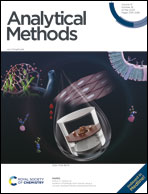A five-electrode capacitively coupled contactless conductivity detector with a low limit of detection†
Abstract
The conductivity detector is a broadly used device that allows for the highly efficient detection of analytes, and continuous efforts have been directed toward lowering the limit of detection. In this study, a five-electrode capacitively coupled contactless conductivity detector (TIC4D) is proposed, which uses copper mesh between the electrodes for a grounding shield to reduce the interference of stray capacitance and noise. After adding the copper mesh shield, the difference value between the response signal and baseline at low KCl concentration is effectively increased, achieving 33 mV for 10−9 M KCl solution. Meanwhile, for the unshielded detector, the difference is only 18 mV for the KCl solution at the same concentration. The response signal shows a linear function of the logarithm at the range of 10−4 M to 10−5 M KCl solution, and the TIC4D detector displays a higher slope (0.8448) than the conventional single-input capacitively coupled contactless conductivity detector (C4D: 0.5579) and dual-input capacitively coupled contactless conductivity detectors (DIC4D: 0.6173). Moreover, two TIC4D detectors are combined to achieve a dual-channel six-input differential capacitively coupled contactless conductivity detector (SIDC4D), reducing the high baseline levels caused by the multi-signal input. By differentially amplifying the output signal, the high baseline levels and noise interference can be effectively reduced. For the 10−3 M KCl solution, the ratio of the response signal to baseline for SIDC4D can reach 8.500, almost 7 times that of TIC4D, and a lower limit of detection (LOD) of 3 × 10−10 M is also achieved. This work may open a new door based on coupled contactless conductivity for detection performance.



 Please wait while we load your content...
Please wait while we load your content...